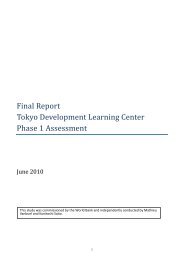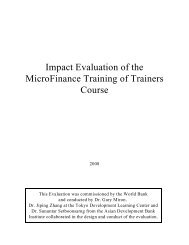Dr. Ian Wilderspin (Vietnam) (PDF) - Tokyo Development Learning ...
Dr. Ian Wilderspin (Vietnam) (PDF) - Tokyo Development Learning ...
Dr. Ian Wilderspin (Vietnam) (PDF) - Tokyo Development Learning ...
You also want an ePaper? Increase the reach of your titles
YUMPU automatically turns print PDFs into web optimized ePapers that Google loves.
Common Goals, Collective Action<br />
The identification of vulnerable communes<br />
for the community-based disaster risk<br />
management (CBDRM) programme of the<br />
Government of Viet Nam<br />
<strong>Dr</strong>. <strong>Ian</strong> <strong>Wilderspin</strong><br />
Technical Specialist, Disaster Risk Management, UNDP Viet Nam<br />
and<br />
<strong>Dr</strong>. Le Dang Trung<br />
Indochina Research and Consulting (IRC), Viet Nam<br />
Presentation for The World Bank<br />
Disaster Risk Management in East Asia and the Pacific<br />
Distance <strong>Learning</strong> Seminar Series 2013<br />
SESSION 1 Community-Based Disaster Risk Management (CBDRM)<br />
Lessons learned and way forward<br />
January 17, 2013<br />
http://www.un.org.vn
Overview<br />
• Objectives<br />
• Risk assessment methodology:<br />
components of the Integrated Risk Index<br />
and data sources<br />
• Calculation process<br />
• Example of results of Integrated Risk<br />
Index for some provinces<br />
• Expected future outputs
Objectives<br />
• To develop a scientific, objective and<br />
feasible methodology for ranking risk in<br />
all 11,112 communes of the 63 provinces<br />
of Viet Nam<br />
• To identify 6,000 communes out of the<br />
total as the most vulnerable communes<br />
for particular attention under the<br />
Government CBDRM programme
Conceptualization of vulnerability to<br />
disasters<br />
• The characteristics and circumstances of a community,<br />
system or asset that make it susceptible to the<br />
damaging effects of a hazard. There are many aspects<br />
of vulnerability, arising from various physical, social,<br />
economic, and environmental factors. (UNISDR, 2009)<br />
• Vulnerability indices must cover impacts of climate<br />
change to economic, environmental and social systems<br />
(IPCC 1995, 2001, 2007)<br />
…We need a comprehensive vulnerability index that is<br />
aggregated from economic, environmental and social<br />
vulnerability indices
Methodology<br />
What we need…<br />
An Integrated Risk Index that is able to<br />
utilize all nationally available data to<br />
capture important dimensions of natural<br />
hazards in Viet Nam and that is<br />
computable at the commune level
Potential approaches to the<br />
selection of communes<br />
• Self-proposed approach<br />
• Systematic ranking approach
Self-proposed approach<br />
Technical characteristics<br />
o Vulnerability ranking is implemented independently within<br />
each province, through selection by provincial authorities<br />
based on various criteria („self selected‟ or „predetermined‟)<br />
o It is likely to be based on a subjective judgment of local<br />
experts and politicians<br />
Potential limitations<br />
o There is no foundation for comparability across provinces<br />
o Vulnerability may not be defined well enough or defined<br />
according to the same national definition<br />
o Vulnerability and selected communes are identified based on<br />
„quotas‟ rather than objective criteria and can be strongly<br />
affected by unwanted factors<br />
o It can take a very long time to implement
Systematic ranking approach<br />
Technical characteristics<br />
o Vulnerability ranking is implemented equally and with same<br />
methodology for all the communes in the country<br />
o It is based on objective evaluation using scientific methods<br />
and with extensive commune disaggregated data<br />
Strengths<br />
o Vulnerability is well defined and it is easy to compare<br />
between communes, districts and provinces<br />
o All dimensions that contribute to vulnerability can be<br />
included if data is available<br />
o Communes are selected based on their vulnerability<br />
characteristics rather than „quotas‟<br />
o It is objective, scientific and not affected by unwanted<br />
factors
Systematic ranking approach<br />
Certain limitations<br />
o Need for data disaggregated by communes<br />
o Data sets need to be accessible for the whole country<br />
o Selection of indicators in composite index can be<br />
subjective BUT can be avoided through participatory<br />
process and discussion<br />
o Weighting depends on preference of user, therefore<br />
equal weighting preferred, with exceptions, e.g. on<br />
hazard prevalence per region*<br />
o Scientific method not always easy to comprehend
Methodology<br />
Hazard<br />
Measured by<br />
intensity and<br />
probability<br />
Hazard Potential<br />
Vulnerability<br />
Hazard Exposure<br />
Risk Index<br />
Coping Capability<br />
Source: Greiving (2006), originally adopted by Schmidt-Thomé (2005)
Vulnerability index<br />
Risk Index<br />
Methodology<br />
Tropical storms<br />
(Wind > 35knot, probability 0 ≤ p ≤ 1)<br />
„Disastrous’ rainfall<br />
(Daily rainfall > 51mm, probability 0 ≤ p ≤ 1)<br />
<strong>Dr</strong>ought<br />
(Yearly rainfall < 250mm, probability 0 ≤ p ≤ 1)<br />
Other hazards<br />
(Probability, 0 ≤ p ≤ 1)<br />
Hazard Potential<br />
Population<br />
(0 ≤ value ≤ 1)<br />
Population density<br />
(0 ≤ value ≤ 1)<br />
Hazard Exposure<br />
Asset index<br />
(0 ≤ value ≤ 1)<br />
Proportion of temporary houses<br />
(0 ≤ value ≤ 1)<br />
Proportion of female population<br />
(0 ≤ value ≤ 1)<br />
Dependency ratio<br />
(0 ≤ value ≤ 1)<br />
GDP at the province level<br />
(0 ≤ value ≤ 1)<br />
Coping Capacity<br />
Source: developed from Greiving (2006)
Components of Integrated Risk Index<br />
Hazard Potential<br />
INDICATOR<br />
• Tropical storms: measured by the<br />
likelihood of being hit by storms<br />
• Rainfall floods: measured by the<br />
likelihood of being affected by heavy<br />
rainfall (day-total rainfall > 51mm)<br />
• Rainfall droughts: measured by the<br />
likelihood of experiencing periods without<br />
rainfall (month-total rainfall < 30mm)<br />
• Other hazards: measured by the<br />
likelihood of experiencing other disasters<br />
(whirlwind, landslides, flash floods and<br />
run-off floods)<br />
DATA SOURCE<br />
• Tropical storms: best-track archives of<br />
all storms that hit Viet Nam between<br />
1951 and 2010<br />
• Floods and droughts: daily rainfall from<br />
172 weather stations all over the country<br />
for the period from 1975 to 2006<br />
• Other hazards: Viet Nam Central<br />
Committee for Flood and Storm Control<br />
disaster database that records all<br />
disasters that happened from 1989 to<br />
2010
Components of Integrated Risk Index<br />
Hazard Exposure<br />
INDICATORS<br />
• Population size: total persons in the<br />
community<br />
Coping Capacity<br />
DATA SOURCE<br />
• Population and assets:<br />
Population Census 2009<br />
• Literacy ratio: Proportion of literate population<br />
• Asset index: Possession of main assets, including:<br />
telephone, TV, motorbike, refrigerator, washing<br />
machine and air-conditioner<br />
• Temporary house: main pier, roof and walls of the<br />
house made of temporary materials<br />
• Dependency ratio: proportion of population aged<br />
< 15 or > 64 years<br />
• District-level poverty rate: poverty headcounts at<br />
the district level<br />
• Poverty rate: Results of poverty<br />
mapping (World Bank and<br />
General Statistics Office of Viet<br />
Nam)
Hazard potential<br />
This index constructed from four hazard components, including: storms,<br />
rainfall flood, rainfall drought and other hazards (such as hail, flash flood,<br />
landslides and whirlwind)<br />
Equal weights were not used as:<br />
o frequencies and impacts of these components can be different -<br />
storms appear to be the most devastating both in terms of<br />
frequency and damage<br />
o weights are also affected by the accuracy level (or measurement<br />
errors) of the data<br />
The component “other hazards” calculated using CCFSC‟s database<br />
available only at provincial level<br />
This results in a lot of „noise‟ when assuming that all the communes in a<br />
particular have the same level of risk of “other hazards”<br />
By contrast, storms, rainfall flood and rainfall drought components are<br />
calculated at the commune level
Hazard potential<br />
Relied on the CCFSC‟s database to calculate the weights for these four components of<br />
Hazard Potential<br />
Took into consideration the following aspects to assign weights to each component the<br />
share of:<br />
o human losses due to each type of hazard<br />
o houses destroyed or damaged by each type of hazard<br />
o bridges destroyed or damaged by each type of hazard<br />
o communication poles destroyed or damaged by each type of hazard<br />
Argued that human losses and house losses should play more important role in capturing<br />
the aftermath of a disasters than bridge and communication pole damage<br />
Accordingly, assigned weights for each of these sub-components as follows:<br />
o Human losses: 35%<br />
o House losses: 35%<br />
o Bridge losses: 15%<br />
o Communication pole losses: 15%<br />
To account for in-country regional heterogeneity of disasters, weights of risk components<br />
of the Integrated Risk Index were calculated at the regional level
Hazard exposure<br />
There are four sub-components including the:<br />
i. proportion of dependent population<br />
ii.<br />
proportion of illiterate population<br />
iii. proportion of female population, and<br />
iv. size of population normalized to ensure its value<br />
ranges between zero and unity<br />
Equal weights were assigned to the four<br />
components
Coping capacity<br />
The coping capacity index is constructed<br />
from three indicators, including:<br />
o poverty headcount at the district level<br />
o the asset index<br />
o the proportion of temporary houses.<br />
Equal weights were assigned to these three<br />
components
Calculations<br />
Step 1: Hazard potential<br />
Step 2: Hazard exposure<br />
Step 3: Coping capability<br />
HP i<br />
=<br />
HE i<br />
=<br />
CC i<br />
=<br />
åw hp j<br />
*h ij<br />
åw he k<br />
*e ik<br />
åw cc l<br />
*c ic<br />
Step 4: Risk index<br />
Risk i<br />
= W hp<br />
* HP i<br />
+W he<br />
* HE i<br />
+W cc<br />
*CC i
The Integrated Risk Index<br />
The risk index is calculated using the<br />
following formula:<br />
Risk = 0.65*(Hazard Potential) +<br />
0.15*(Hazard Exposure) + 0.20*(Coping<br />
Capacity)
A distributional summary<br />
..of the Integrated Risk Index of all 11,112<br />
communes in Viet Nam<br />
Density<br />
Integrated Risk Index
Integrated Risk Index<br />
for Viet Nam
Integrated Risk<br />
Index for Gia<br />
Lai province
Expected future outputs<br />
• Online atlas of all communes in the 63 provinces of Viet Nam<br />
comprising:<br />
o A set of maps per province showing the Integrated Risk<br />
Index for all communes colour coded (for low, media and<br />
high risk)<br />
o Identification of the most vulnerable communes<br />
(communes with largest values of integrated risk index)<br />
o Baseline indicators (of nationally available statistics for<br />
each province)<br />
o Collation of all available data sets per provinces (including<br />
digital hazard maps, links to other data sources, contact<br />
details of Provincial government authorities and main<br />
stakeholders, etc.)<br />
• Online hub for non-government and development agencies to<br />
gather and input information from their operation<br />
• Publications including guidance notes and specific reports
Thank you very much<br />
For further information please contact:<br />
<strong>Dr</strong>. <strong>Ian</strong> <strong>Wilderspin</strong> <br />
and<br />
<strong>Dr</strong>. Le Dang Trung

















